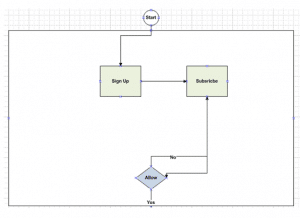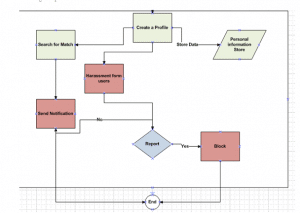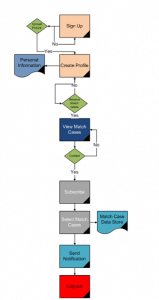MODELING ENTERPRISE ARCHITECTURES
Business modelling is the standalone structure, which defines all the attributes of any business organization. The business model describes the different functional and non-functional parts of the business organization. In this assignment, there is a need to model the business of Valentinos in the right direction. The aim of the study is to renovate the enterprise modelling structure with the help of the activity, prototype diagram (Bhuiyan et al., 2018).
The behavioural aspect of a system can be drawn by the help of the activity diagram with recognising the individual aspects of the behavioural model. The activity diagram mainly focuses on the workflow in the system from the starting to the final approach of the project. The following activity diagram mainly describes the individual business activity of Valentinos, which will highlight the existing features of their online application. As opined by de Sousa et al., (2017)the first activity diagram mainly portraits the different activities from the previous assignments and it mainly focuses on the different task panes. The primary step will be started with the help of the sign-up process of the users. If the users are already a member then the pages have been accelerated to the login page. The next step of propagating towards the profile creation of the new users is required. Then the users need to register their personal information along with their photographs.

Figure 1: Overall activity diagram 1
(Source: Microsoft Visio)
This information will be helpful for finding the ideal matches for the bachelors. After this process has been done, there is a need to start another parallel process, which includes accepting and blocking the profile of the users from the chosen list. Then the next process mainly describes the decision-making module of the users to choose a particular profile under some circumstances. This process mainly matches the characteristics of the users in a very specific way starting from their hobbies to personal interest. The activity diagram mainly displays the individual activities and model of the business in a very specific way in the existing system. Likewise, in the given case scenario, it has been found that the business model of Valentinos mainly focuses on the login and signup procedures.

Figure 2: Overall activity diagram 2
(Source: Microsoft Visio)
The activity diagram 2 mainly focuses on the transition between the individual steps in a detailed manner. The activity diagram is very much different from the basic flow chart because this diagram focuses on the structured transition state of each and individual activity. The renovation in the online application of Valentinos makes a huge difference in their business strategy and increases their overall revenues. The user can subscribe to the online application with £150 per year, which will increase their profits and enhance the target audience greatly. In addition to finding a match, creating a profile and mutual notification sending is one of the major features of the updated algorithm (King, 2016).
The overall application of functioning of the system is represented by the Prototype Design 1. As discussed by Zafar, et al., (2016) application creation is done based on the prototypes. An application can never be stand out without the creation of an effective prototype. The user will be asked to enter personal details and information to sign up with the application. The details and information asked while signing up is interrelated to the working method of the application. The user can enter the necessary details by clicking on the confirmation button. All the information of the users will be saved in the personal information data store, once the profile of the application is created. Apart from this, the relevant match cases will be provided by the application.
Based on the preferences and choices of the users, the relevant match cases will be provided. One a user gets a matching case; the application will ask the user to contact the interaction with the other user. Besides, when the user is ready to contact the other user, the application will send a message to the user for a subscription. Moreover, once the subscription process is done, the user will be notified. In order to improve the efficiency of the application, the annual subscription is required. After getting the subscription, the user will be allowed to contact other users. The application will also provide an option to view more match cases. Based on the chosen option, the user will be redirected to the rest of the procedures.

Figure 3: Prototype Design 1
(Source: MS Visio)
Design 2

Figure 4: Prototype Design 2
(Source: MS Visio)
The second prototype design of the application requires the user to sign up. After the user signs up to the page, he, or she is required to upload a picture. The first step of authentication about the application is a picture of the individual. After the individual is done with uploading a picture, he or she can now sign up and create a profile. Once the profile is created, the user can evaluate all the match cases. As per a study by Madanayake et al., (2016) the match cases are all provided by the application.
Once a particular user wants to communicate with a match, he or she has to go through the process of subscription. Without proper subscription, a person cannot communicate with the other personnel. After the user has subscribed to the application, selection of the match cases is required by a user. After the selection, the user can either store the match cases data into the application or can communicate with them directly.
The third prototype of the file requires the user to sign up to the application. On signing up, the user will be taken through a series of plans for a subscription. Without an appropriate subscription, he or she cannot go through the entire application. As per the study by Madanayake et al., (2016) after the user has subscribed, he or she can add personal information to the application. After the user has filled in all the details, the user can now add preferences based on what he or she likes in a person.
On completion of preferences, the user can start viewing all the match cases. All match cases will appear on his or her application screen. If the user matches with anyone then he or she will get a notification. Once the user wants to chat with anyone, he or she will have to wait for a match, once match is confirmed; the application will congratulate the individual.
Figure 5: Prototype Design 3
(Source: MS Visio)
Social media handles are included in the last prototype associated with linking of application of social media. According to the views of Bhuiyan et al., (2018), in order to increase security, social media platforms play an important role. The integration of the prototype with social media involves the signing up of the application followed by verification of the personal information provided by the user. However, once the user has subscribed to the application, the process of integration will be followed (Michael Muckin, Scott, 2016).
The verification of the account will be done after integration. This linkage will help the users to log in to their social media profiles and can proceed with their match cases. In addition, this match cases depends on the preferences of the users and the accounts that are linked with the social media profiles of the users. Lastly, after the successful matching, the users can successfully interact with other users through chatting options that are available in the social media platforms.
Figure 6: Prototype Design 4
(Source: MS Visio)
The term “sequence diagram” mainly refers to the process in which the core interaction between the different objects present in a sequential manner is described. In order to describe the sequential activities, the different sequential diagram has been used to prepare that depicts the important key objects within even scenario.
Figure 7: Sequence diagram for the first prototype
(Source: Microsoft Visio)
The first prototype diagram for the organization, Valentino is used to describing the login procedure within the organization. As per the diagram, first, it is important to check-in by the new users and thus the process will be initiated. After this, the administrator of the organization will validate the new users within the organization. As suggested by de Sousa et al. (2017) In order to validate the new users, the administrator will utilize the credential access and thus will control the entire process. According to this diagram, the users can also access the Valentino plan by the details of registration and also by completing the entire payment methods. As per the diagram shown above, it will also allow the users to find its matches and also to chat with an individual for build-up purpose of the application (Murali et al., 2017).
Figure 8: Sequence diagram for the second prototype
(Source: Microsoft Visio)
The second prototype diagram for Valentino organization has clearly shown the relationship and interconnection among users, administrators and also the processes within an organization. The company has an extra security system so that any users cannot access the database of the company. As a result of this, this entire prototype has made it possible to secure the security for the entire organization. According to this sequence diagram, the administrator acts as the intermediate phase between users and processing database.
Figure 9: Sequence diagram for the third prototype
(Source: Microsoft Visio)
Therefore, when a new user tries to log in within the system, the administrator automatically gets the notification and from the database, they have to grant the request for entering into the system. This will help to identify all the activities within the department and also to understand what kind of necessary precautions are needed to take. Same things will also be applicable for the chatting and the subscription purpose, where the administrator will monitor the searching for a match and will also verify the entire process. However, it can be observed that as there are several databases within the organization system, thus the entire process will be ineffective. As a result of this, it is important to incorporate an artificial intelligence system within the organizational system.
According to the third prototype prepared in the sequence diagram, it depicts the starting of the program along with the check-in procedure by the users; it shows that when the user will check-in into the program, automatically the application manager program will be started. In the opinion of Madanayake et al., (2016) this entire prototype diagram helps to illustrate the functionality of the entire scenario with the help of an orderly system functioning procedure. Like mentioned in the above diagram, these users and application managers are involved within the system. In spite of this, this diagram also includes signing up portion, profile creation methods, and validation procedures. It also enables the chance to view match cases, different facilities for chat purpose and also subscription methods that control the sequential flow to explain the system functioning.
Figure 10: Sequence diagram for the fourth prototype
(Source: Microsoft Visio)
As per the fourth prototype of the sequence diagram, it depicts the interconnection between object and also with the process. It can be observed that the entire prototype diagram is effective to illustrate the functionality of a particular scenario. This fourth prototype also helps to understand the distribution of workload from a single managerial application. It also states that entire match cases, chatting procedures, blocking users will be entirely controlled by the application manager with the help of profile management tools. In the last, the end process in the prototype will help to close the loop after completion of core runtime scenarios by each user within the organization (Ruffy, et al., 2016).
Figure 11: Elaborated class diagram
(Source: Microsoft Visio)
The class diagram mainly focuses on the individual attributes and method for processing the stages in a critical way. From the previous assignment, there is a need to improve the different individual models of the class including the login and sign up section. In the opinion of van de Wetering, R., &Bos (2016) the match finding section also needs to be improved with the basic requirements. The class diagram shows the individual attributes including the users, system admin and the external visitors of the dating agency.
The admin can anytime activate or deactivate the account of the individual users in case of any necessity. The user can update their photograph and personal information with the help of the online application module. This will help the users to authenticate entry to the website with the help of the administrative permission. Based on the class diagram the java code has been designed with the specific methods and terms. The different classes and methods have been updated to refurbish the online application of Valentinos.
Development of state chart diagram
Figure 12: State chart diagram
(Source: Microsoft Visio)
The state chart diagram mainly depicts the architectural behaviours of the different activities in a detailed manner. This diagram shows all the possible stimuli of the given activities in a specific way. The following state chart diagram forecast on the different entities of the online application to improve their business strategy and productivity. The single object mainly illustrated the necessary changes in the overall activity of the diagram, which mainly focuses on the transition of the given model. As commented by de Sousa et al., (2017) the individual definite number of stages is classified under the class diagram and the individual objects are defined in the form of a state chart diagram in a very specific way. According to the case study, the state chart diagram must include the following objects starting from the creation of a profile, finding matches and login pages, which need to be specific in the timeline. The completion of the profile is done after the successful payment procedures and user participation in the review of the applications.
Figure 13: Entity relationship diagram
(Source: Microsoft Visio)
The entity-relationship diagram mainly focuses on the association and dependency between the individual class with the help of the attributes and entities. The aggregation and composition between the different entities will be graphically represented here which focuses on the functional dependencies between the individual attributes. The basic model mainly highlights the composite view of the overall structure with the detailed specification of the attributes and entities. The entity-relationship diagram mainly studies the multifunctional views and dependency of the object in the class. The core part of the entity-relationship model are the users, admits, find matcher and the external visitors who can search for matches without registration. The different attributes of the users are comprised of user-id, mobile number, date of birth, email id, the salary of the individual users (Zafar, et al., 2018). .
The match case preference will be evaluated with the help of the different users, which can be structured in a proper way. The admin can handle all the accounts and accept user requests and permission with the help of the individual methods. The entity-relationship diagram mainly focuses on the detailed views of the entities and attributes which can focus on the individual class dependency of the specific object.
Public class Valentinos IT revamp
{
Public static void main (string args [])
{
Public public class user
{
/** Attributes */
Public userID (Varchar)
Public Profile (Varchar)
Public Name (String)
Public Address (String)
Public E-mail Id (String)
Private Mobile Number (Number)
Public Education (String)
Public Salary (Number)
Public Hobbies (String)
Public DOB (Number)
/** Methods */
Void Boolean check ()
Void Search ( )
Void Edit ( )
Void User Update ( )
Void Register ( )
}
Public class account
{
Private class Match
{
/** Attributes */
Private matchId (varchar);
Private message ID (varchar);
Private Timestamp (time);
Private location (varchar);
/** Methods */
Void match ();
Void unmatch ();
}
Public Class System admin
/** attributes */
{
Private Admin Id (String)
Private Password (String)
}
/** Methods */
Void add Member ( )
Void delete Member ( )
Void Send Mail ( )
Void Update Database ( )
Public class message implements Match
/** Attributes */
Private messageId (varchar);
Private matchId (varchar);
/** Methods */
Void match ();
Void SearchForNewMatch ();
}
Public class like
{
/** Attributes */
Public userid (varchar);
Public messageId (varchar)
Account Id ();
/** Methods */
Void GoingForDate ();
Void notInterested ();
}
In this java code there is a need to identify the the individual class the specification of the method that is mentioned in this case study. The code specifies individual class and the specific methods, which are incorporated in the java code.
The Zachman framework mainly describes the architectural part of the organization including the vision, mission, and the business strategy. As per the view of Lapalme et al, (2016), the framework mainly demonstrates the detailed structural view of the enterprise Valentinos that consist of the different objects and methods of the project. The benefits of the Zachman framework demonstrated in the following points:
- The framework mainly describes the function, network, and time for the Valentinos enterprise in a structured manner that highlights dependency between the attributes.
- The enterprise characteristics for the detailed engagement of the individual features have been demonstrated with the help of the two-dimensional matrix.
| Data
(what) |
Function
(how) |
Network
(where) |
People
(who) |
Time
(when) |
Motivation
(why) |
|
| Objectives | Individual functional and non-functional requirements | Class diagram and activity | Broadband and internal network | Admin and employees | 4 months | In order to survive in a competitive industry |
| Business Model | Data map development | Process analysis of organisation | Network routers and switches | Owner and stakeholders | 8 months | Enhancement of existing modules |
| Information System Model | Class diagram explaining different modules | Development of component | Data distribution through oracle | Employees and managers | 4 months | Development stage transaction |
| Technology model | Can be said a physical implementation of data models | Developer | Development with ERD | End-user | 4 weeks | UI recreation |
| Detailed representation
|
User data | Sequence and class diagram | Data distribution | Admin | 5 weeks | Development and understanding the features |
| Working System | ||||||
| Functioning Enterprise | Data | Network Individuality | Function | Schedule | 3 weeks | Performance |
Table 1: Zachman Framework
(Source: Case Study)
It conclusion to the study it can be said that the business modeling of the enterprise Valentinos has been depicted to update their online application website and the database with the help of the C++ and SQL languages. The study also focuses on the activity, prototype diagram that will facilitate the relationship between the methods and objects of the study. Valentinos is a famous dating agency in Australia, which offers a large number of facilities for the bachelors to find their matches. The study mainly focuses on refurbishing the business environment of Valentinos in great aspects.
Bhuiyan, M., Haque, F., Shabnam, L., Mekami, H., Benabderrahmane, S., Bounoua, A., …& Ishii, N. (2018). Integration of organisational models and UML Use Case diagrams. Journal of Computers, 13, 1-18. Retrieved from: https://www.researchgate.net/profile/Farzana_Haque5/publication/327886245_Integration_of_Organisational_Models_and_UML_Use_Case/links/5d58988692851cb74c74caad/Integration-of-Organisational-Models-and-UML-Use-Case.pdf, [Retrieved on 17th February, 2020].
de Sousa, T. C., Kelvin, L., Neto, C. D., & de Carvalho, C. G. N. (2017). A Formal Semantics for Use Case Diagram Via Event-B. JSW, 12(3), 189-200. Retrieved from: http://www.jsoftware.us/vol12/242-JSW15208.pdf, [Retrieved on 17th February, 2020].
King, F., (2016). “Education: No 2 target for Cyber Attacks in 2016.” Retrieve from https://www.netswitch.net/education-2-target-for-cyber-attacks-in-2016
Madanayake, R., Dias, G. K. A., &Kodikara, N. D. (2016). Use Stories vs UML Use Cases in Modular Transformation. International Journal of Scientific Engineering and Applied Science (IJSEAS)–Volume-3, Issue-1, ISSN, 2395-3470. Retrieved from: https://s3.amazonaws.com/academia.edu.documents/51425862/User_Stories_vs_UML_Use_Cases_in_Modular_Transformation_Final_IJSEA_version.pdf?response-content-disposition=inline%3B%20filename%3DUser_Stories_vs_UML_Use_Cases_in_Modular.pdf&X-Amz-Algorithm=AWS4-HMAC-SHA256&X-Amz-Credential=AKIAIWOWYYGZ2Y53UL3A%2F20200219%2Fus-east-1%2Fs3%2Faws4_request&X-Amz-Date=20200219T052748Z&X-Amz-Expires=3600&X-Amz-SignedHeaders=host&X-Amz-Signature=e4b51acd25ad63ccf6eda0f302c11f9652931c136b7e53cd19913a9f350d9f9e, [Retrieved on 17th February, 2020].
Michael Muckin, Scott C. Fitch . “A Threat-Driven Approach to Cyber Security.” Retrieve from: https://lockheedmartin.com/content/dam/lockheed/data/isgs/documents/Threat-Driven%20Approach%20whitepaper.pdf
Murali, R., Ireland, A., &Grov, G. (2016, May). UC-B: Use Case Modelling with Event-B. In International Conference on Abstract State Machines, Alloy, B, TLA, VDM, and Z (pp. 297-302). Springer, Cham. Retrieved from: https://pureapps2.hw.ac.uk/ws/portalfiles/portal/10666971/abz_2016_submit.pdf, [Retrieved on 17th February, 2020].
Ruffy, W. Hommel, and F. von Eye, “A STRIDE-based Security Architecture for Software-Defined Networking,” ICN 2016, p. 107, 2016.
van de Wetering, R., &Bos, R. (2016, July). A meta-framework for efficacious adaptive enterprise architectures. In International Conference on Business Information Systems (pp. 273-288). Springer, Cham. Retrieved from: https://s3.amazonaws.com/academia.edu.documents/47243018/Van_de_Wetering_Efficacious_adaptive_EA_idea_v_final.pdf?response-content-disposition=inline%3B%20filename%3DA_meta-framework_for_Efficacious_Adaptiv.pdf&X-Amz-Algorithm=AWS4-HMAC-SHA256&X-Amz-Credential=AKIAIWOWYYGZ2Y53UL3A%2F20200219%2Fus-east-1%2Fs3%2Faws4_request&X-Amz-Date=20200219T052434Z&X-Amz-Expires=3600&X-Amz-SignedHeaders=host&X-Amz-Signature=8418cc29d34fa77f72fea75c9ef3b5409588bb374c1698bda6db6f8ac2af8a9b, [Retrieved on 17th February, 2020].
Zafar, U., Bhuiyan, M., Prasad, P. W. C., &Haque, F. (2018). Integration of Use Case Models and BPMN Using Goal-Oriented Requirements Engineering. JCP, 13(2), 212-221. Retrieved from: https://pdfs.semanticscholar.org/c50b/7d39dca1764c5faff39cd6a7d73446d1d468.pdf, [Retrieved on 17th February, 2020].


